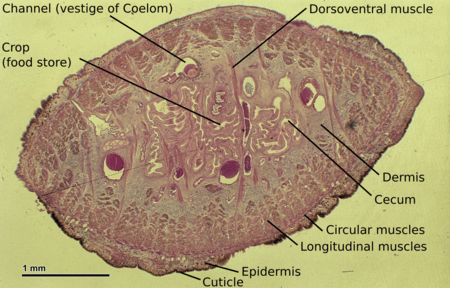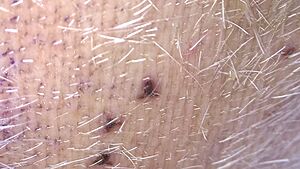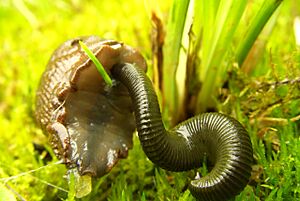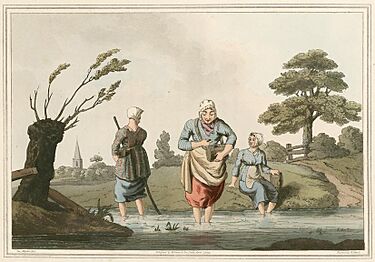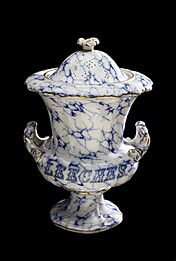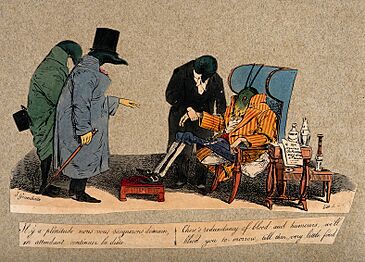Leech facts for kids
Quick facts for kids Leech |
|
|---|---|
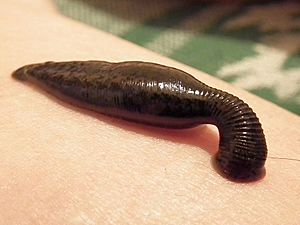 |
|
| Hirudo medicinalis sucking blood | |
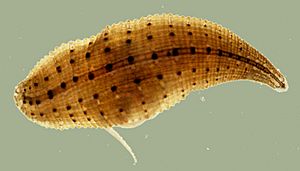 |
|
| Helobdella sp. | |
| Scientific classification |
|
| Kingdom: | Animalia |
| Phylum: | Annelida |
| Class: | Clitellata |
| Subclass: | Hirudinea Lamarck 1818 |
Leeches are fascinating worms that belong to a group called Annelids, just like earthworms. They have soft, muscular bodies divided into segments. Leeches can stretch out or shrink their bodies. Most leeches have special suckers at both ends. These suckers help them move around and attach to things.
Many leeches live in freshwater, like ponds and lakes. Some kinds live on land or in the ocean. The most famous leech is the medicinal leech, Hirudo medicinalis. This type of leech feeds on blood. It attaches to a host with its sucker and releases a special substance called hirudin. This substance stops the blood from clotting, so the leech can drink easily.
Other leeches are predators. They hunt and eat small invertebrates, like insects or snails. Leeches lay their eggs inside a protective case called a cocoon. Aquatic leeches often attach their cocoons underwater. Some leech families, like the Glossiphoniidae, even care for their eggs and young! Land-dwelling leeches hide their cocoons under logs or in damp soil. There are almost 700 known species of leeches around the world.
People have used leeches in medicine for a very long time. In ancient times, they were used to "draw blood" from sick people. Today, leeches are still used in modern medicine. They can help treat joint problems and vein diseases. They are also useful in microsurgery to help blood flow. The substance hirudin from leeches is even used as a medicine to prevent blood clots.
Sometimes, the word "leech" is used to describe someone who takes a lot from others without giving back.
Contents
Amazing Leech Diversity
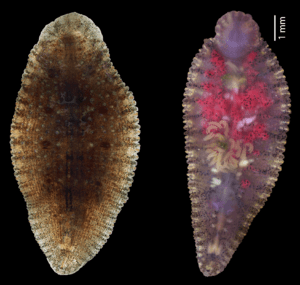
Scientists have described about 680 different kinds of leeches. Around 100 species live in the sea, 480 live in freshwater, and the rest live on land. The smallest leeches are only about 1 centimeter (0.4 inches) long. The largest is the giant Amazonian leech, Haementeria ghilianii, which can grow up to 30 centimeters (12 inches)!
Leeches live almost everywhere in the world, except Antarctica. They are most common in the northern parts of the world, especially in temperate lakes and ponds. Most freshwater leeches prefer shallow areas with lots of plants. They usually avoid fast-moving water. In good habitats, you might find many leeches living close together. Some leeches can survive droughts by burying themselves in the mud. They can lose a lot of their body weight and still live!
Some freshwater leeches, like the Glossiphoniidae, are flat. They often live as parasites on animals like turtles. What's special about them is that they carry their eggs and young on the underside of their bodies.
Land leeches, like the Haemadipsidae, mostly live in tropical and subtropical areas. Water leeches, like the Hirudinidae, are found all over the world. Both of these types often feed on mammals, including humans. Another interesting family is the Piscicolidae. These are marine or freshwater leeches that mainly live on fish.
Not all leeches drink blood. The Erpobdelliformes are freshwater or amphibious leeches that are carnivores. They have a large mouth without teeth and swallow insect larvae, snails, and other worms whole. In turn, leeches can be eaten by fish, birds, and other invertebrates.
The name "Hirudinea" comes from the Latin word hirudo, which means leech. The word -bdella in many leech names comes from the Greek word for leech, too.
How Leeches Evolved
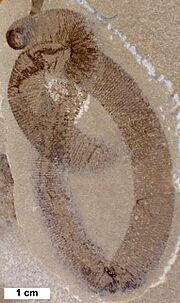
The oldest group of worms related to leeches are the free-living polychaetes. They first appeared about 500 million years ago. Earthworms (oligochaetes) evolved from polychaetes. Leeches then branched off from the earthworm group. The oldest clear leech fossils are about 266 million years ago. There's also a possible leech fossil from about 300 million years ago.
Leech Anatomy and Body Systems
Leeches look quite similar to each other. Unlike many other worms, their body cavity (called a coelom) is mostly filled with a special tissue. This makes their bodies very solid. Leeches are usually flat and get narrower at both ends. They have strong muscles that let them change their body shape a lot. Most leeches have a sucker at their front and back ends. Some simpler leeches only have a back sucker.
Leeches are segmented animals, but their segments are hidden by many external rings. The number of these rings can vary. However, all leech species have 32 main body segments, called somites. The first five segments make up the head, which includes their brain and several eyespots. The next 21 segments contain nerve centers. These segments also hold their reproductive organs. The last seven segments are fused to form the tail sucker.
Leeches have a thick body wall with strong circular, diagonal, and longitudinal muscles. These muscles give them great flexibility and strength. Unlike many other worms, leeches don't have a typical blood circulation system. Instead, their body fluid (called haemocoelomic fluid) acts like blood. They also have special organs called metanephridia that help them get rid of waste.
Reproduction and Life Cycle
Leeches are hermaphrodites. This means each leech has both male and female reproductive organs. The male organs mature first, and then the female organs.
After mating, leeches lay small eggs that don't have much yolk. These eggs are protected inside a cocoon. When the eggs hatch, the young leeches look for hosts if they are near the water's edge. Most leeches live for one or two years.
How Leeches Eat and Digest Food
About three-quarters of leech species are parasites that feed on blood. The rest are predators. Leeches either have a mouth with jaws or a special tube called a proboscis that they can push out.
Leeches without a proboscis have three sharp blades in their mouth. When they bite, these blades make a Y-shaped cut in the host's skin. Behind the blades is the mouth, which leads to a tube called the pharynx. Some species have a crop, which is a large part of their gut that stores the blood they drink. Leeches release an anticoagulant called hirudin in their saliva. This stops the blood from clotting. A medicinal leech might only feed twice a year. It can take months for them to digest a single blood meal!
Predatory leeches have a similar body structure. Instead of jaws, many have a proboscis that they keep hidden in their mouth. These leeches often wait quietly for prey. Then, they quickly strike with their proboscis, like a spear. Predatory leeches eat small invertebrates like snails, earthworms, and insect larvae. They usually swallow their prey whole.
Blood-sucking leeches use their front sucker to attach to their hosts. Once attached, they use mucus and suction to stay in place. They then inject hirudin into the host's blood. Most blood-feeding leeches are not picky about their hosts. They usually don't harm the host much. They simply drop off once they are full of blood. Some marine species, however, stay attached until it's time to reproduce. If many leeches are on one host, they can make the host very weak.
Leeches are special because they don't make some common digestive enzymes. Instead, they rely on helpful bacteria that live inside them. These bacteria produce the enzymes and vitamins that leeches need to digest their food. This is why digestion in leeches can be very slow.
Leech Nervous System
A leech's nervous system is made of a few large nerve cells. Because these cells are big, scientists often study leeches to learn about how invertebrate nervous systems work. The main nerve center is a ganglion (a cluster of nerve cells) above the gut. Another ganglion is below it. Nerves connect these two, forming a ring around the pharynx. A nerve cord runs down the leech's body with 21 pairs of smaller ganglia.
Leeches have between two and ten eyespots at the front of their bodies. They also have special sensory bumps on their skin. These bumps contain many sensory cells. Some leeches can even change their color dramatically by moving pigment cells.
Leeches can sense touch, vibrations, movement nearby, and chemicals from their hosts. Freshwater leeches can quickly swim or crawl towards a potential host in their pond. Leeches that feed on warm-blooded animals move towards warmer objects. Many leeches avoid light, but some blood-feeders move towards light when they are ready to feed, which might help them find a host.
How Leeches Breathe
Leeches live in wet places and usually breathe through their skin. However, the Piscicolidae family is an exception. They have special gill-like growths on their bodies that help them breathe. Some leeches have a special pigment called haemoglobin in their body fluid, similar to blood. This helps carry oxygen, but most of their oxygen still comes from simply absorbing it through their skin.
How Leeches Move
Leeches move by using their strong muscles in a unique way. They use their front and back suckers to "loop" or "inch" along, much like a geometer moth caterpillar. First, they attach their back sucker to a surface. Then, they stretch their front end forward as far as it can reach and attach the front sucker. Next, they release the back sucker and pull their body forward. Then, they reattach the back sucker, release the front, and the cycle repeats.
-
Leeches move by looping using their front and back suckers.
Leeches also explore their surroundings by moving their heads and waving their bodies. Some leeches, like the Hirudinidae, can swim very fast by wiggling their bodies up and down or side to side. Other leeches, like the Glossiphoniidae, are not good swimmers. If disturbed, they often curl up and drop to the bottom.
Leeches and Humans
Leech Bites
Leech bites are usually more scary than dangerous. However, a small number of people can have serious allergic reactions. These reactions might include red blotches, an itchy rash, swelling around the lips or eyes, feeling dizzy, or having trouble breathing. If a leech is attached to you, it will usually fall off on its own once it's full of blood. This can take from 20 minutes to a few hours. The bite might bleed for a while afterward. If a leech attaches inside your nose or another internal spot, you might need a doctor's help.
Bacteria and other tiny parasites can live inside a leech for months. So, leeches could potentially spread diseases. But, there have only been a few reported cases of leeches actually passing diseases to humans.
Many people think leech saliva contains a substance that numbs the bite area. However, some experts disagree about this.
Medical Uses of Leeches
The medicinal leech, Hirudo medicinalis, has been used in medicine for at least 2,500 years. Ancient texts from India describe their use for bloodletting. In ancient Greece, doctors used leeches to balance the body's "humours" (fluids) if they thought there was too much blood.
Pliny the Elder, a Roman writer, mentioned that horse leeches could make elephants crazy by climbing into their trunks! He also wrote about leeches being used in ancient Rome for conditions like gout. He noted that patients sometimes became addicted to the treatment. In old English, the word lǣce meant both a physician and the animal.
-
This funny drawing from around 1832 shows three leech doctors deciding to use bloodletting on a grasshopper patient.
In the 1800s, people called "leech-gatherers" would collect leeches from the wild in Britain. This caused a big drop in the number of leeches. By 1863, hospitals in London had to import millions of leeches from other countries.
The use of leeches in medicine decreased as doctors learned more about the body. However, leeches made a small comeback in the 1980s. This was thanks to microsurgery, where tiny blood vessels are reconnected. Leeches can help reduce swelling and improve blood flow after these surgeries, especially when reattaching body parts. They are also used for conditions like varicose veins and joint diseases.
Leech saliva contains many helpful substances. These substances can reduce inflammation, prevent blood clots, and even fight germs. One important substance is a small protein called hirudin. It is now made using modern technology and used as a medicine to treat blood-clotting problems.
Scientists have even used leeches to study the animals in tropical rainforests. In Vietnam, researchers collected leeches and found mammal mitochondrial DNA in their blood meals. This helped them identify rare and hidden mammals in the forest, like the Annamite striped rabbit and serow. This method can help scientists learn more about biodiversity.
See also
 In Spanish: Sanguijuelas para niños
In Spanish: Sanguijuelas para niños



